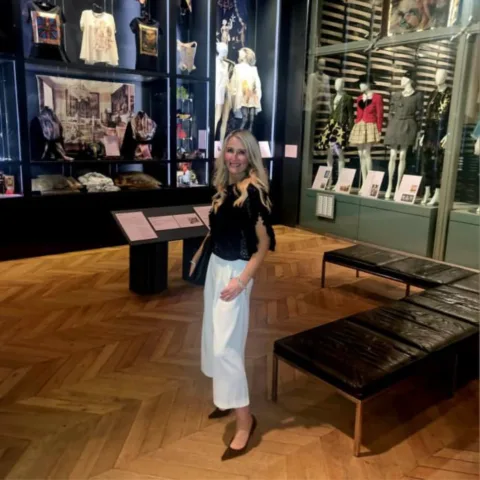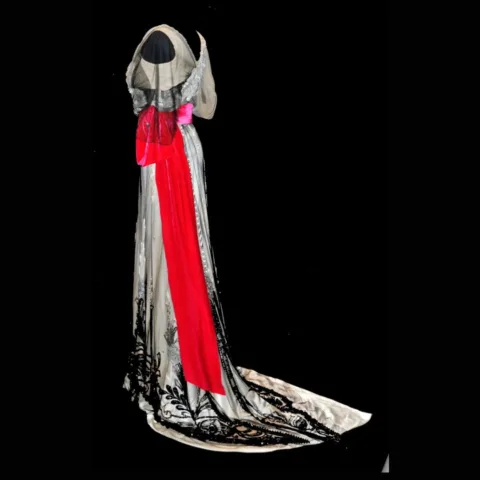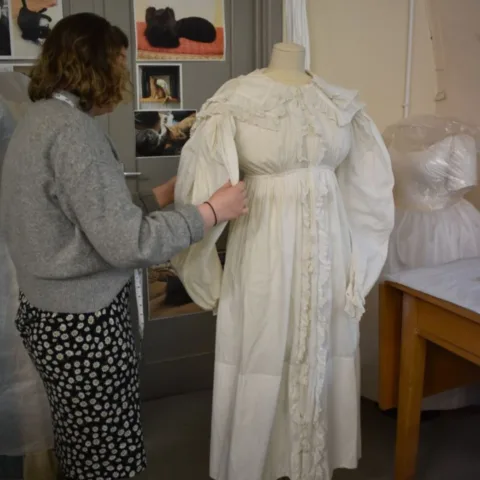The Bowes Museum Blog

Obsession: Empress Eugenie’s Shoe Collection
In 1953 a large donation of relics of the French Empire were given to The Bowes Museum by Miss Alice Edleston, when clearing her brother’s estate. She wrote to the curator, ‘The odds and ends in (the) box all come from the Empress’s sale at Farnborough Hill’. Miss Edleston (1864-1956) was a local historian and her brother, Robert Holmes Edleston (1868 -1953) had a lifelong interest in the Second Empire, writing a number of books on Napoleon III. They lived in Gainford, a village eight miles west of Barnard Castle.
Forming part of the Edleston gift was a selection of fashionable dress owned and worn by Empress Eugénie, consort of Napoleon III from 1853-1871. The Empress was a leader of fashion, known as ‘The countess of the Crinoline’, and was dressed by the principal couturier of the time, Charles Frederick Worth.
The selection of garments comprises two jackets, seven bodices, a waistcoat, four stoles, two shawls and four belts, five pairs of shoes, two single shoes, two pairs of boots and a pair of gaiters. Most, if not all, of these items were bought from a sale held by Christie, Manson & Woods on 24 July 1923 in London. Empress Eugenie’s shoe collection contains a selection of silk and leather slippers and boots which will form part of the ‘Obsession’ section in our upcoming exhibition Shoes: Pleasure and Pain.

Eugenie’s shoe collection, 1860-1870
Flat shoes were in vogue for women from the Empire period to the romantic era. Delicate and subtle materials were selected to match the style of dress. When shorter length dresses were introduced, translucent fabrics and embroidered stockings made a popular alternative. During the mid-1860s shoes had squared toes, small heels and thicker soles. The thinner-soled shoes were predominantly used for dancing.

Silk and Leather Shoes, 1860s

Maker’s label
Five pairs of Eugenie’s shoes are marked with the stamp Viault-Esté, 17 Rue de la Paix, Paris. Rue de la Paix was first opened in 1806, off the Place Vendôme, by Napoleon I. In 1870s Palais Garnier was unveiled pushing Rue de la Paix to the centre of Parisian fashionable life.

Black silk shoes, 1860s

Black silk shoes, 1860s
It is likely that these two single black shoes (each for the right foot) would have been marked with Viault-Esté, 17 Rue de la Paix, Paris.
The collection also features a pair of fur lined carriage boots and a pair of ice skating boots.

Carriage boots, c.1870
These boots are navy velvet and fur-lined (mink and rabbit), with black ribbon ties and a higher, shaped heel; known as the Louis heel, from the similarity to the heels of French 18th century shoes. These types of boots were known as carriage boots. They were lined with fur to keep feet warm during the winter period.

Ice skating boots, c.1862
Much like the enthusiasm for cycling in the 19th century, skating became a popular leisure activity. It was during this period that figure skating, ice hockey and speed skating were introduced as distinct sports. Ice skating was popular amongst socialites and Eugenie’s skating boots are a good example. Here, we see a fashionable pair of boots with a low heel which have a pair of ice-skate blades attached. The metal blades are designed to be easily removed for walking and leisure activities. The skirt would have been raised to the ankle for such activities, so the decorative white stitching would be more visible.
Other pieces from Empress Eugenie’s effects include this gold necklace with feather shaped filigree and a white silk Paletot jacket, embellished with gold embroidery (back on show in the fashion and textile gallery in late 2016).

Gold necklace, c.1855

Gold necklace, c.1855

Paletot jacket, c.1862
Empress Eugenie’s shoes will go on display in Shoes: Pleasure and Pain, alongside a collection of Founders’ shoes, which were purchased by John and Joséphine Bowes at the International Exposition, Paris in 1867.
Further reading:
Fashioning the Bourgeoisie: A History of Clothing in the Nineteenth Century, Philippe Perrot
Sports and Games of the 18th and 19th Centuries, Robert Crego
Shoes: Pleasure and Pain, Helen Persson
By Hannah Jackson, Assistant Curator of Fashion & Textiles







